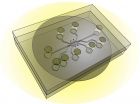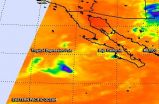(Press-News.org) Most of the fires captured in this image burn in Khabarovsk Krai, a territory occupying the coastline of the Sea of Okhotsk. Dozens of red hotspots, accompanied by plumes of smoke mark active fires. The smoke, which appears mostly white or grey, blows to the east towards the Sea of Okhotsk. Taiga and tundra are found in the north of this area, swampy forest inhabit the central depression, and deciduous forests are the natural vegetation in the south.
While large wildfires are common in Russia in the summer, the 2014 wildfire season appears to be more intense than usual. According to Russia's ITAR-TASS news agency, some 12,600 forest fires had burned over 1.8 million hectares (7,000 square miles) as of July 16, 2014. That's about three times more than last year at that point, according to statistics maintained by Russia's federal forestry agency. It looks as though the wildfires are not dying down yet as evidenced by this natural-color satellite image taken by the Moderate Resolution Imaging Spectroradiometer (MODIS) aboard the Aqua satellite on September 22, 2014. Actively burning areas, detected by MODIS's thermal bands, are outlined in red.
INFORMATION:
NASA image courtesy Jeff Schmaltz, MODIS Rapid Response Team. Caption: NASA/Goddard, Lynn Jenner
Wildfires in Khabarovsk Krai, Russia
2014-09-22
ELSE PRESS RELEASES FROM THIS DATE:
New chip promising for tumor-targeting research
2014-09-22
WEST LAFAYETTE, Ind. – Researchers have developed a chip capable of simulating a tumor's "microenvironment" and plan to use the new system to test the effectiveness of nanoparticles and drugs that target cancer.
The new system, called a tumor-microenvironment-on-chip (T-MOC) device, will allow researchers to study the complex environment surrounding tumors and the barriers that prevent the targeted delivery of therapeutic agents, said Bumsoo Han, a Purdue University associate professor of mechanical engineering.
Researchers are trying to perfect "targeted delivery" methods ...
Brainwave test could improve autism diagnosis and classification
2014-09-22
September 22, 2014 – (BRONX, NY) – A new study by researchers at Albert Einstein College of Medicine of Yeshiva University suggests that measuring how fast the brain responds to sights and sounds could help in objectively classifying people on the autism spectrum and may help diagnose the condition earlier. The paper was published today in the online edition of the Journal of Autism and Developmental Disabilities.
The U.S. Centers for Disease Control and Prevention estimates that 1 in 68 children has been identified with an autism spectrum disorder (ASD). The signs and ...
Common diabetes drug associated with risk of low levels of thyroid hormone
2014-09-22
Metformin, a commonly used drug for treating type 2 diabetes, is linked to an increased risk of low thyroid-stimulating hormone (TSH) levels in patients with underactive thyroids (hypothyroidism), according to a study in CMAJ (Canadian Medical Association Journal). Low levels of TSH can cause harm, such as cardiovascular conditions and fractures.
Metformin is used to lower blood glucose levels by reducing glucose production in the liver. However, some previous studies have raised concerns that metformin may lower thyroid-stimulating hormone levels.
Researchers looked ...
University of Chicago neuroscientists challenge long-held understanding of the sense of touch
2014-09-22
Different types of nerves and skin receptors work in concert to produce sensations of touch, University of Chicago neuroscientists argue in a review article published Sept. 22, 2014, in the journal Trends in Neurosciences. Their assertion challenges a long-held principle in the field—that separate groups of nerves and receptors are responsible for distinct components of touch, like texture or shape. They hope to change the way somatosensory neuroscience is taught and how the science of touch is studied.
Sliman Bensmaia, PhD, assistant professor of organismal biology and ...
Variability keeps the body in balance
2014-09-22
Although the heart beats out a very familiar "lub-dub" pattern that speeds up or slows down as our activity increases or decreases, the pattern itself isn't as regular as you might think. In fact, the amount of time between heartbeats can vary even at a "constant" heart rate—and that variability, doctors have found, is a good thing.
Reduced heart rate variability (HRV) has been found to be predictive of a number of illnesses, such as congestive heart failure and inflammation. For athletes, a drop in HRV has also been linked to fatigue and overtraining. However, the underlying ...
NASA sees Tropical Depression Polo winding down
2014-09-22
Infrared satellite imagery from NASA's Aqua satellite showed only a swirl of low-level clouds some deep clouds around Polo's weakening center on Sept. 22 as the storm weakened to a depression.
The Atmospheric Infrared Sounder or AIRS instrument aboard Aqua gathered infrared data on Polo on Sept. 22 at 5:11 a.m. EDT, reading cloud top temperatures. There was a small area of high clouds, indicating that most thunderstorms in the depression had weakened or already dissipated except for that area.
At 5 a.m. EDT on Monday, Sept. 22, Tropical Depression Polo's maximum sustained ...
Compound from hops aids cognitive function in young animals
2014-09-22
CORVALLIS, Ore. – Xanthohumol, a type of flavonoid found in hops and beer, has been shown in a new study to improve cognitive function in young mice, but not in older animals.
The research was just published in Behavioral Brain Research by scientists from the Linus Pauling Institute and College of Veterinary Medicine at Oregon State University. It's another step toward understanding, and ultimately reducing the degradation of memory that happens with age in many mammalian species, including humans.
Flavonoids are compounds found in plants that often give them their ...
Engineers show light can play seesaw at the nanoscale
2014-09-22
University of Minnesota electrical engineering researchers have developed a unique nanoscale device that for the first time demonstrates mechanical transportation of light. The discovery could have major implications for creating faster and more efficient optical devices for computation and communication.
The research paper by University of Minnesota electrical and computer engineering assistant professor Mo Li and his graduate student Huan Li has been published online and will appear in the October issue of Nature Nanotechnology.
Researchers developed a novel nanoscale ...
Graphene imperfections key to creating hypersensitive 'electronic nose'
2014-09-22
Researchers have discovered a way to create a highly sensitive chemical sensor based on the crystalline flaws in graphene sheets. The imperfections have unique electronic properties that the researchers were able to exploit to increase sensitivity to absorbed gas molecules by 300 times.
The study is available online in advance of print in Nature Communications.
Amin Salehi- Khojin, asst professor of mechanical and industrial engineering in the lab with Mohammad Asadi, graduate student and Bijandra Kumar, post doc where they are doing research in graphene sensors. Photo: ...
Gravitational waves according to Planck
2014-09-22
No one has ever directly observed gravitational waves, phenomena predicted by Einstein's theory of General Relativity, and such a discovery would have profound implications for the study of the Universe. Last March, however, the team behind the BICEP2 project made a ground-breaking announcement: the Antarctic observatory had detected a signal referable to gravitational waves. The study claimed to have excluded possible contaminants (other sources that could have generated the same signal) and that the observation was therefore to be considered genuine. But not everyone ...




